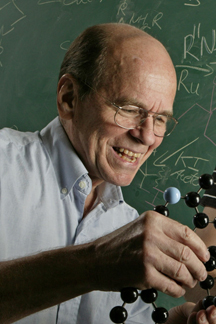WSU to host Nobel Prize winner, Dr. K. Barry Sharpless, W.M. Keck Professor of Chemistry at Scripps Research Institute - Sept. 22
"Wayne State University's 2015 Ahmed H. Zewail Lecture"
Tuesday, September 22, 2015, 2:00 - 3:30 p.m.
Marvin I Danto Engineering Development Center Auditorium,
College of Engineering, Room 1507 Engineering Building
"Click Chemistry: New Directions"
Presented by: Professor K. Barry Sharpless, The Scripps Research Institute
 Faculty, staff and students are invited to the 2015 Ahmed H. Zewail Lecture. This year's presenter will be Professor K. Barry Sharpless, the W. M. Keck Professor of Chemistry at the Scripps Research Institute, San Diego, CA.
Faculty, staff and students are invited to the 2015 Ahmed H. Zewail Lecture. This year's presenter will be Professor K. Barry Sharpless, the W. M. Keck Professor of Chemistry at the Scripps Research Institute, San Diego, CA.
The Zewail Lecture will take place on September 22, 2015 in the Marvin I. Danto Engineering Development Center Auditorium, located at 5050 Anthony Wayne Drive, Room 1507 from 1:30 to 3:30 p.m. A reception with refreshments will begin at 1:30pm, followed by an introduction and presentation of the Zewail Medal at 2 p.m. in the EDC auditorium, and concluding with Dr. Sharpless's lecture at 2:30 p.m. The event is free and open to the public, but registration is required. To register, visit http://rsvp.wayne.edu/zewail2015/
Dr. Sharpless is best known among synthetic chemists for discovering and developing many widely used catalytic oxidation processes, especially the work for which he received a Nobel Prize in 2001, the first general methods for asymmetric oxidation—the Sharpless reactions for asymmetric epoxidation (1980), dihydroxylation (1988) , and aminohydroxylation (1996).
Among a newer generation of scientists representing the entire chemical spectrum, from chemical engineering and materials to chemical biology, Sharpless is known for click chemistry, a term he coined in 1998. Inspired by the complexity nature achieves from a handful of building blocks, Sharpless started actively looking in the mid-90s for a way to discover new chemical connectivity and reactivity. Click chemistry did not gain momentum until his group's discovery of CuAAC (the copper-catalyzed azide-alkyne cycloaddition), a near-perfect reaction (2002). Recently the Sharpless group discovered SuFEx, also near-perfect for click chemistry. In concert with the thiol-ene reaction, these three make click chemistry a far-reaching method for discovery chemistry.
In 2011 Thomson Reuters named the top 100 chemists whose papers published in the first decade of the 21st Century achieved the highest citation impact scores: Sharpless was number 4.
Sharplesses' mentors at Dartmouth (BA ,1963), Stanford (PhD, 1968, and postdoc), and Harvard (postdoc) were Professors T. A. Spencer, E. E. van Tamelen, J. P. Collman, and K. Bloch, respectively. Before joining The Scripps Research Institute (TSRI) in 1990 as W. M. Keck Professor of Chemistry, he was a long-time member of the MIT chemistry faculty, except for three years at Stanford (1977-1980)
Some of Sharplesses' honors include the Chemical Sciences Award of the National Academy of Sciences (elected member, 1985), the Roger Adams and Arthur C. Cope Awards of the American Chemical Society, the Tetrahedron Award, the King Faisal Prize, the Prelog Medal, the Wolf Prize, and over twenty honorary doctorates and professorships.
Lecture Abstract: Click chemistry was introduced as a conceptual frame-work for functional molecular assembly 17 years ago, emphasizing the importance of carbon-heteroatom linkages in joining modular building blocks. Sulfur(VI) Fluoride Exchange (SuFEx) chemistry, a new type of click chemistry recently, forges rugged inorganic links between carbon centers. Like most click reactions, it is an old process with a rich and instructive history. We surveyed that history and discovered new improvements that allow the underappreciated sulfate connection to be made for drug discovery and polymer fabrications
Contact info
Julie O'Connor
Director, Research Communications
Phone: 313-577-8845
Email: julie.oconnor@wayne.edu